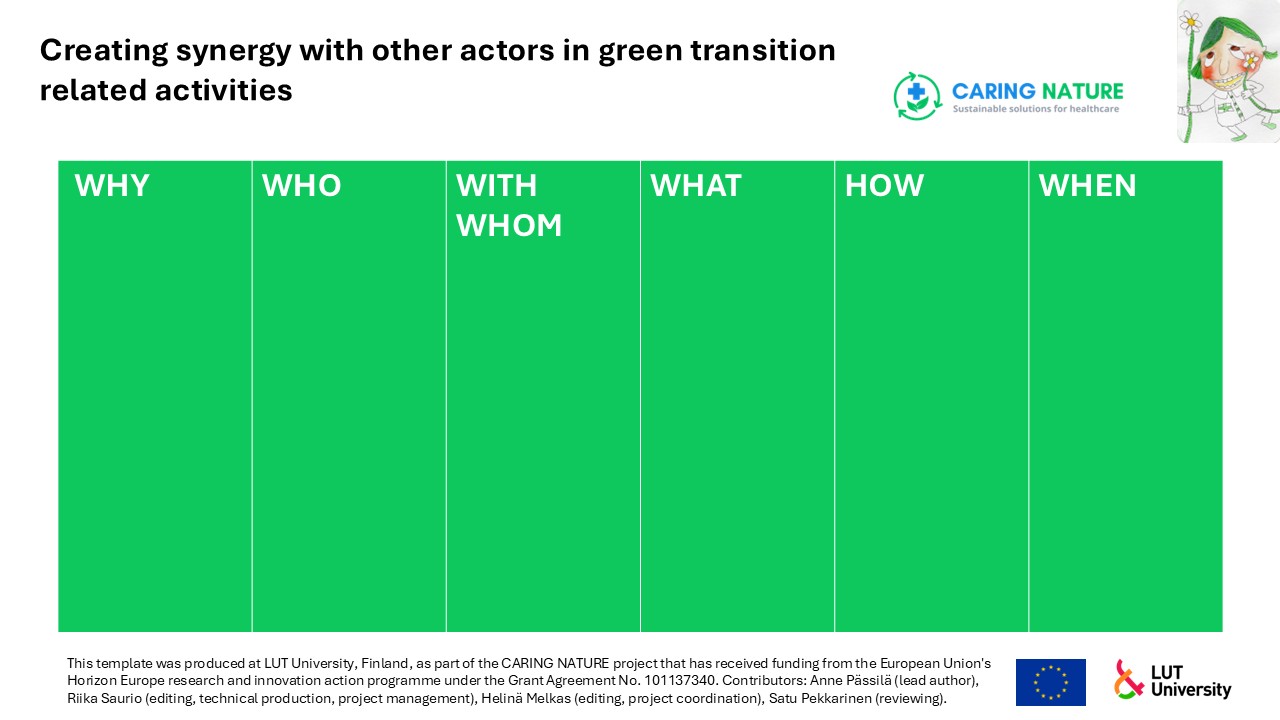‘WHY, WHAT, WHERE, WHEN’ TECHNIQUE IN GROUP WORK
Paradigm-preserving methods
The Why, What, Where, When technique is a simple and effective method for structuring and deepening green transition related ideas. It allows health and care staff to look at an environmental topic from different perspectives, encouraging creative thinking and systematic brainstorming. The method is structured around four basic questions: Why? What? Where? When? These help the group of health and care professionals to clarify objectives, identify problems and opportunities, and develop new solutions.
What is required:
- Openness and participation: participants are expected to actively contribute ideas and be willing to share their thoughts.
- Structured thinking: the question structure allows for ideas to be considered from different perspectives, which requires concentration and the ability to construct ideas logically.
- Group interaction: the method works best when participants discuss and develop their ideas together.
Level of difficulty: 1-2 (easy and applicable to different situations)
Time required: 20-45 minutes, depending on the size of the group and the complexity of the topic
Materials:
- A flipchart, post-it notes or a digital tool to compile responses
- A Why, What, Where, When table (drawn on paper or available digitally)
Participants: 3-10 people per group. In larger groups, it is possible to split into small groups and later combine ideas.
How to use:
- Defining the topic
- The facilitator introduces the method and identifies the topic to be discussed.
- Generating ideas through questions
- The group will start to produce answers to the four core questions:
- Why? (Why is this matter important? Why does this phenomenon occur?)
- What? (What is involved? What can we do about it?)
- Where? (Where does this matter have an impact? Where can it be utilised?)
- When? (When is it relevant? When should action be taken?)
- Participants can write their answers on paper, post-it notes or a digital whiteboard.
- Grouping and deepening ideas
- Once the answers have been collected, they are compiled into the Why, What, Where, When table where they can be compared and combined.
- The group discusses the themes identified and looks for links between the different answers.
- Compiling the final insights
- The group selects the most important or insightful answers and considers how they can be put into practice.
When to use:
- In the early stages of brainstorming, when you want to take a broad view of the topic.
- In the planning phase, when you want to structure ideas before making a decision.
- In problem-solving situations when it is necessary to understand the different dimensions of the problem and to find new perspectives.
Why to use:
- Clarifies thinking: the method helps to structure complex issues and highlights key questions.
- Promotes debate: the question structure encourages participants to look at issues from different perspectives.
- Suitable for a variety of situations: can be used in strategic planning, problem solving and brainstorming workshops.
How to document:
- Saving the table: can be captured on a flipchart or saved to a digital document.
- Writing down key findings: the facilitator or group can write a summary of key findings.
- Defining the next steps: if the method is used for planning, the next steps and the responsible persons can be written down.
The roots of the method can be found here: The Why, What, Where, When method is based on the classic principle of question-based thinking, which has been widely used in scientific research, education and decision-making. It is also related to critical thinking and systematic analysis, as discussed in the Socratic method and creative problem-solving models (Osborn, 1953).
